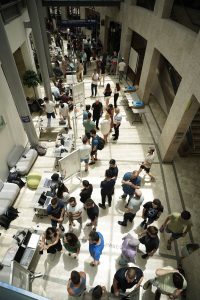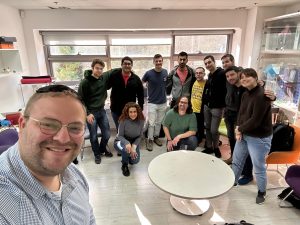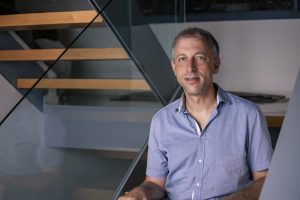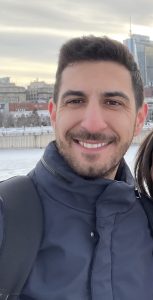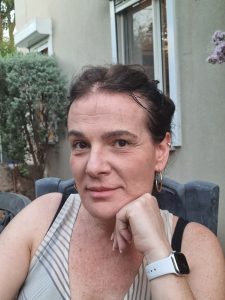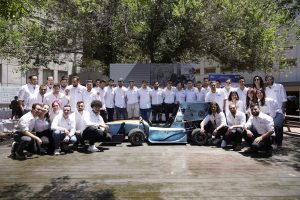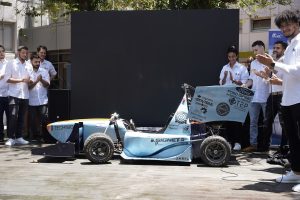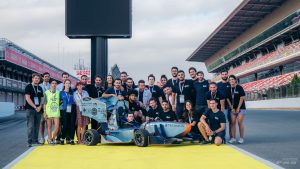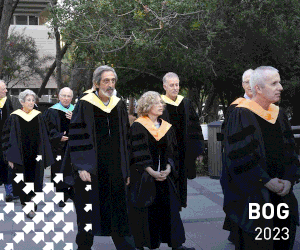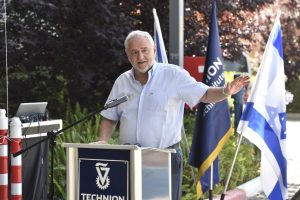Researchers in the Andrew and Erna Viterbi Faculty of Electrical and Computer Engineering have demonstrated control over an emerging material, which they consider as a possible future alternative to silicon in microelectronics. This is a timely development, because scientists and engineers face challenges in continuing the transistor shrinking trend, an important driver of computer chip performance.

L-R: Dr. Maria Baskin, Lishai Shoham, Prof. Lior Kornblum
Integrated circuits, more commonly known as computer chips, or simply chips, are at the core of modern life, responsible for processing, storing, and transferring massive amounts of data. Chips are responsible for countless tasks, including vaccine development, spacecraft designs, internet infrastructure, big data, autonomous vehicles, artificial intelligence, and the internet of things.
The continuous performance improvement of these chips has been driven by shrinking the size of the most basic logic “Lego” piece – the transistor. Transistors are miniature switches that control the flow of electric currents, analogous to a faucet controlling the flow of water. Already in the early 1960s, Gordon Moore, the founder of Intel, proposed that the transistors’ miniaturization rate should allow doubling of the number of transistors per area every 2 years. This prediction, coined Moore’s Law, has dictated the miniaturization rate for decades. Presently modern chips contain billions of transistors on about a square centimeter.
In 2007, Moore declared that his law would come to an end within a few years. The CEO of Nvidia expressed an even more pessimistic view last year, saying that “Moore’s Law is dead,” a view shared by other technology experts.

L-R: Dr. Maria Baskin, Prof. Lior Kornblum and Lishai Shoham, in the lab
Professor Lior Kornblum of the Viterbi Faculty of Electrical and Computer Engineering explains that, “as a result of the continuous miniaturization, modern transistors are only a few dozen atoms across. Because they are already so small, continuing miniaturizing without compromising their performance is becoming increasingly challenging. On the nanometric scale, the transistors behave in new ways that are different than their larger predecessors.”
One manifestation of this problem is leakage of electric current when the transistor (switch) is supposed to be off. Prof. Kornblum explains that “it can be compared to a leaking faucet, multiplied by a billion; this could result in a lot of wasted ‘water.’ In a modern phone with billions of transistors, the tiniest current leakage will accumulate into a considerable waste of energy. This could quickly drain the battery and cause excessive heating of the device. Zooming out, when thinking server farms and data centers, the energy waste can be substantial and produce considerable heat.”
There are multiple approaches and strategies to tackle these challenges. One promising direction is the search for alternatives to silicon, the workhorse of today’s chips. Prof. Kornblum’s research group is studying various oxide materials, one of which has a useful property: it can switch from being an electrical conductor to an insulator – and back. The researchers want to harness this property for future transistors that could potentially switch more efficiently.

L-R: Dr. Maria Baskin, Lishai Shoham, and Prof. Lior Kornblum in the Sara and Moshe Zisapel Nanoelectronics Center
Developing such a technology requires precise control of the material properties. The Technion researchers demonstrated a route for manipulating the material’s electric properties by precisely controlling the distance between its atoms. Laboratory manager, Dr. Maria Baskin, achieved this by using a unique oxide growth system; she deposited layers of atoms one on top of the other, thereby growing films of the material. Thanks to this delicate growth process, she was able to set the distances between atoms with a picometer (one-thousandth of a nanometer) precision. In comparison, the distance between two atoms in silicon is approximately one-quarter of a nanometer, or 250 picometers.
This unique oxide growth system was established at the Technion with significant investment, and it is the enabler for developing the next generations of semiconductors, magnetic materials, and renewable energy materials such as cutting-edge catalysts.
“Every morning, I come to the lab and ‘fire-up’ the system,” explains Dr. Baskin. “We can choose from a variety of atoms, control their arrangement and the spacing between them. Using these capabilities, we can even create materials that did not exist before, with a broad range of properties per our requirements.”
“The tools we’ve developed for the oxides growth are unique,” adds Prof. Kornblum, who heads the laboratory. “Oxide growth is only the first step. From there, the graduate students start their research. Some focus on the materials’ physical properties, striving to understand how they function, and some utilize these materials to fabricate electronic devices that we hope will revolutionize microelectronics, renewable energy, and other fields.”

The heart of the lab – the oxide growth system
Ph.D. student Lishai Shoham’s research addresses both of these aspects. She is studying the material’s properties and fabricating transistors from it, aiming to evaluate how it can be harnessed for microelectronics. In her latest scientific publication, Shoham led a team of twelve other researchers from eight research institutions and companies, located in Switzerland, Japan, France and the United States. The team showed that by stretching the material at the atomic level, the elongation of the chemical bonds between the atoms changes the electrical properties: stretching by less than 2% of the atomic bond length, the researchers reduced the electrons’ tendency to hop from atom to atom. Furthermore, this stretching changed how the atoms were arranged in space. Through these tiny changes, which take place at a scale of one picometer, the researchers developed the groundwork for controlling the material’s transition from a conducting state to an insulating state.
According to Shoham, “It is amazing to see that such minute changes in the material’s atomic structure have such a big impact on the electrical properties. We took this material to a synchrotron in Switzerland and saw how these tiny alterations affect the electrons’ arrangement in the material, as well as their behavior. These are the scientific foundations we need, in order to develop future transistors from these unconventional materials. Today, I am implementing the results of our research on related materials, from which I am developing a new type of transistor.”
According to Prof. Kornblum, “it is a great privilege to develop these capabilities here in Israel, to work with brilliant students and collaborate with the world’s leading scientists who contributed to this research. We are reaping the fruits of the excellent scientific infrastructure that the Technion is constantly developing and improving, and of our excellent students.”
The research was conducted at the Sara and Moshe Zisapel Nanoelectronics Center. It was funded by the Israel Science Foundation and supported by the Russell Berrie Nanotechnology Institute and the Nancy and Stephen Grand Technion Energy Program.
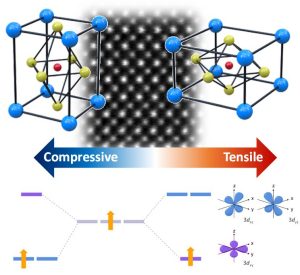
The atomic structure of the material strontium vanadate – illustration of the material’s atomic structure under stretching (right) and compression (left). The center shows the actual atomic arrangement, as imaged by an electron microscope. The bottom illustrates the effect of the stretching and compression on the material’s energy levels and therefore the way in which the electrons are arranged. By controlling these properties, the researchers intend to engineer these materials into future transistors.
Read the full article here: https://onlinelibrary.wiley.com/doi/full/10.1002/adfm.202302330



